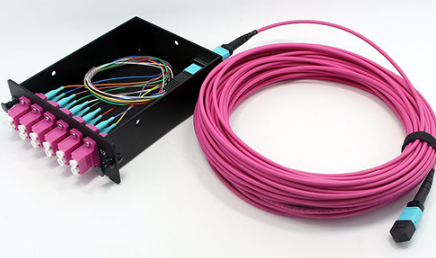MPO Fiber Optic Path Testing: Methods, Precision Factors, and Common Test Approaches
Methods and Tools for MPO Fiber Optic Path Installation
Installing MPO fiber optic cables requires a combination of specialized techniques and tools. Firstly, it is crucial to have a thorough understanding of the MPO fiber's structure and operational principles to ensure accurate installation and connection. Additionally, it is essential to match the transceiver wavelengths at both ends of the fiber to avoid any communication issues. This can often be achieved by visually checking for consistent color coding on the transceiver modules.

www.adsscable.cn
During the installation process, it is important to handle the fiber gently, avoiding excessive force that could displace the fiber core and compromise the quality of optical communication. Special attention should be paid to cleaning the ceramic ferrules and end faces of the fiber jumpers, using alcohol and lint-free cotton to eliminate any dust or contaminants that could interfere with the optical signal transmission.
Moreover, the choice of installation method depends on the specific application. Depending on the need, one can choose between straight-through or flip-over MPO jumpers for the connection. Once the installation is complete, optical path testing is essential to verify the stability and reliability of the fiber connection.
It is advisable to entrust the installation of MPO fiber optic cables to professional fiber optic technicians, as they possess the necessary skills and expertise to ensure accurate and reliable installations.
Precautions and Considerations for MPO Fiber Optic Path Testing
When conducting MPO fiber optic path testing, it is crucial to adhere to certain precautions and considerations to ensure accurate and reliable results.
Firstly, safety should always be the top priority. Ensure that the testing equipment and instruments are properly configured and adhere to safety regulations before proceeding with any tests.
Secondly, it is important to avoid damaging the fiber optic cables. Inspect the fibers for any cracks, bends, or other damage before testing. If any damage is found, it should be repaired or replaced before testing.
Cleanliness is also a key factor. The connector heads and sockets should be cleaned using a clean alcohol swab to remove any dirt or debris. This ensures a clear and uninterrupted optical path for accurate testing.
Moreover, it is essential to consider the testing environment. Avoid exposing the fiber optic cables to electrostatic discharge, water, corrosive substances, or extreme temperatures during testing.
Lastly, it is important to use the appropriate testing equipment for the job. Depending on the specific testing requirements, choose the right testing instrument such as an optical power meter or OTDR (Optical Time Domain Reflectometer) to obtain accurate test results.
 www.adsscable.cn
www.adsscable.cn
By adhering to these precautions and considerations, you can ensure the accuracy and reliability of your MPO fiber optic path testing, safeguarding the smooth operation of your fiber optic communication system.
Factors Influencing the Precision of MPO Fiber Optic Path Testing
The precision of MPO fiber optic path testing is influenced by various factors that can affect the accuracy of the results.
Firstly, the precision and performance of the testing equipment play a crucial role. High-quality testing instruments with superior resolution and stability can provide more accurate test results.
Secondly, the choice of testing methodology can also impact precision. Different testing methods may yield different results, so it is important to select the appropriate method based on the specific testing requirements.
The testing environment is another critical factor. Temperature, humidity, and cleanliness can all affect the accuracy of the test results. Fluctuations in temperature, for instance, can cause changes in the refractive index of the fiber, which can influence loss measurements.
Furthermore, the inherent characteristics of the fiber itself can influence testing precision. The type, length, and quality of the fiber can all have an impact. Fibers of different types exhibit different transmission characteristics, while impurities or bubbles in the fiber can lead to inaccurate test results.
www.adsscable.cn

The skill level and experience of the operator are also important considerations. Proper operation techniques and a deep understanding of the testing principles can help operators achieve more accurate results.
Lastly, the quality and compatibility of connectors and adapters used in the testing process can also affect precision. It is essential to use high-quality connectors and adapters that are properly matched and cleaned to minimize any potential impact on test accuracy.
To enhance the precision of MPO fiber optic path testing, it is recommended to employ high-quality testing equipment, select appropriate testing methods, optimize the testing environment, ensure fiber quality, enhance operator skills, and maintain the cleanliness and compatibility of connectors and adapters. These measures can effectively reduce testing errors and improve the overall accuracy of the results.
Common Test Approaches Used in MPO Fiber Optic Path Testing
In MPO fiber optic path testing, several common test approaches are utilized to assess the performance and integrity of the fiber optic links.
One of the fundamental tests is optical power measurement. This involves the

 www.adsscable.cn
www.adsscable.cn